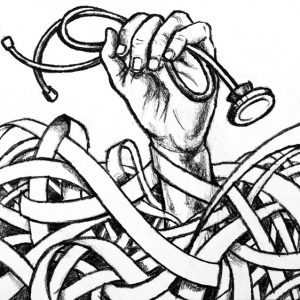by Robert A. Duke
I think we all understand that insurance is protection against the threat of unaffordable loss. That’s all insurance, including healthcare insurance.
But, Tom (not his actual name), Professor Emeritus of Law, and check-writing patient, sees health insurance as an onerous exception to this bland definition, which deserves to be challenged. No other insurance, Tom points out, reminds its insureds — nearly to their last breath — of the threat of unaffordable loss, which healthcare patients face with every contact with the healthcare system. Confessing to a degree of hyperbole, he compares his health insurance experience to his legal profession’s definition of “criminal protection racketeering”: taking money from people in exchange for agreeing not to hurt them.
Others may feel the same way, and many wonder at the incredible cost of health insurance, but few can bring to this accusation Tom’s professional training and sheer volume of experience reading health insurance statements and paying health provider invoices at age 75.
I met him in his Bellingham, Wash. home, nestled against Western Washington University’s campus, where he formerly taught business law. He sat brooding over three-ring binders of healthcare insurance statements and invoices, searching for appropriate examples to illustrate his grievance.
Handing me a rapid series of statements and invoices, he maintained a running tirade of offending examples of threats of unaffordable loss continually hurled at him by healthcare insurers and providers throughout Whatcom County and Washington state.
“See here,” he says, flashing a piece of paper under my nose, “the threat is that I would have to pay this exorbitant amount if I didn’t have insurance. And notice, under the column titled Plan Paid there is nothing. Zero. I paid the whole amount. So, what did insurance do?”
I grabbed the next piece of paper from his hand and lowered it into my lap where I could focus on reading its contents as my host continued his narration. There it was, in black and white. It was identical to all of my own health insurance statements and invoices over even more years than Tom’s.
Example
This example happens to be for laboratory tests, but could be for anything: imaging, specialist consultation, office procedure, consultation, outpatient care, hospital treatment, etc. The form is a Kaiser Foundation Health Plan of Washington Explanation of Benefits, Page 2 of 2, dated 08/18/2018. Of particular interest is the field titled Claim Details consisting of the data in these column headings:
Column Headings
Date of Service 07/18/18
Service Description Health
Service Code 80050
Provider Billed $232.92
Plan Allowed $44.01
Plan Paid $0.00
Patient Responsibility $44.01
Note 3008
The amount the provider billed is the amount the provider (*Quest Diagnostics laboratory) determined was its cost for providing the service of testing for an underactive thyroid gland. Every business establishes a price for its services or products as a normal business practice for whatever it is selling to a customer — for instance, an automobile’s MSRP (Manufacturer’s Suggested Retail Price) “sticker” price.
The way insurance works, the insurer (Kaiser Permanente’s Kaiser Foundation Health Plan of Washington) negotiates a contract (usually for a year) with a range of providers (in this case, Quest Diagnostics) to provide its services to the insurer’s insured (patient) for a fixed price for the next 12 months. In this case, Kaiser Foundation Health Plan of Washington negotiated with Quest Diagnostics a price of $44.01 for its underactive thyroid gland test with a retail price of $232.92.
Quite a feat. An 82 percent reduction in price if the patient purchases the test through Kaiser’s insurance.
Provider Billed — this heading is the retail cost of the test as computed by Quest Diagnostics: $232.92.
Plan Allowed — this heading is the discounted price of the test negotiated by Kaiser: $44.01.
Plan Paid — this heading is how much the insurer, Kaiser, paid of the PLAN. ALLOWED — amount of $44.01: $0.00 (zero).
Patient Responsibility — this heading is the amount the insured patient paid of the PLAN ALLOWED price of $44.01: 100 percent (all).
In Tom’s examples, the insurer paid nothing, but delivered the unnerving message that Tom would have had to pay $232.92 if he didn’t have insurance, which Tom takes as a bald “threat” to his financial solvency from which he must protect himself through the purchase of healthcare insurance.
Every insurance statement, as Tom sees it, is reinforcement of the threat of healthcare bankruptcy that would occur if he didn’t purchase the protection offered by insurers.
Does the insurer ever pay anything, you might wonder? Yes. In one example, the plan paid $3.00 for a blood draw, reducing the Plan Allowed amount from $64.80 to $61.80. But the threat is still there. Without insurance, the provider (again Quest Diagnostics) would have billed $380.20 compared to the plan’s allowed $64.80. The $3.00 the plan paid in this case was for the otherwise $21.37 the provider charged for “Blood-draw-from-vein.” In other Quest blood tests, there is no separate draw charge, but no explanation.
Benefit Summary
At the bottom of this same benefits statement is a field captioned: BENEFIT SUMMARY 01/01/2018 – 12/31/2018.
Within the row titled, “In NETWORK,” is the following summary of cost limits the insured has agreed to:
Individual Annual Deductible: $850.
Individual Out-of-Pocket Limit: $5,000.
Provider’s Invoice
The insurance statement (above) is only a description for information purposes. Payment is made by the insured in response to an invoice from the provider for the service rendered. What follows is a brief description of the bill to the patient.
Quest Diagnostics laboratory invoice (bill) for the underactive thyroid gland test identified in the statement above describes the rendered service. It breaks down the PROVIDER BILLED charge (from the statement) of $232.92 into its constituent parts as follows:
CBC PLT, DIFF $42.18
Comprehensive Metabolic Panel $ 60.25
TSH $130.49
Total $232.92
The invoice also quantifies the Insurance Discount (which didn’t appear on the statement): $181.91.
As in the statement, the patient owes $44.01.
To Tom, this merely amplifies the threat he must protect himself against through healthcare insurance. Besides avoiding paying $232.92, but by insuring, he saved the substantial amount of $188.91 (Insurance Discount).
He paid only $44.01. Wow, what a bargain. Not so fast. Why all the emphasis on Provider Billed ($232.92) and Insurance Discount ($188.91)? What message is the insurer and provider sending the insured? To Tom’s legal and consumer thinking, it could just as well be a fiction or invention, a high-handed fear-inducing threat. Obviously, the services can be provided for $44.01 to the profit of both Kaiser and Quest, at least for the duration of one year.
Looked at Tom’s way, American health insurance has many of the characteristics of a protection racket. If you don’t pay for the system’s protection, it will ruin you. Medical bills are the United States’ number one cause of personal bankruptcy. See below:
“Medical Bankruptcy and the Economy: Do Medical Bills Really Devastate America’s Families?” by Kimberly Amadeo, thebalance.com, May 2018
It is estimated that 2 million people were adversely affected (by medical bills). A popular Facebook meme said that 643,000 Americans go bankrupt each year due to medical costs. President Obama, in his 2009 State of the Union address, said that a medical bankruptcy occurred every 30 seconds. That’s one million bankruptcies in a year.
*See Whatcom Watch July 2017 article about Quest Diagnostics titled: “Lab Sale Sells Out Patients, Burdens Caregivers” by Bob Duke.
____________________________
Purpose of Healthcare Insurance Program Is to Spread Fear
Fifteen days after her emergency room (ER) visit, her insurer, Anthem Blue Cross, informed Brittany Cloyd, by letter: “Your condition does not meet the definition of emergency.” She was responsible for her total ER bill of $12,596.
“The purpose of this program is to spread fear,” said Dr. Ryan Stanton, a critical care and emergency medical specialist in Lexington, Kentucky. Health insurers are making such practices more common according a Doctor-Patient Rights Project (DPRP) study. The study contends that Anthem has instituted an organized policy of denial designed to make its subscribers too afraid to go to an ER for fear of receiving (such) a bill. cbsnews.com.
For more on this story see: https://doctorpatientrightsproject.org/dprpreports/report-access-denied-part-two/.
_______________________________
Robert A. Duke is author of “Waking Up Dying: Caregiving When There Is No Tomorrow,” and lives in Bellingham. His email: boshduke@gmail.com.





























